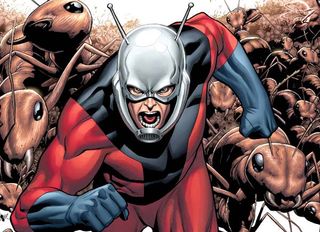Review Sheet Ecosystems Population Size Human Impact Worksheet
Why Aren't Insects Human-Size?

The Ant-Man cometh.
Director Edgar Wright, known for movies such every bit "Shaun of the Dead," announced earlier this week he would be making a movie about Ant-Human, a comic superhero who can shrink to the size of an ant and communicate with his formic brethren, according to the news site Grantland. If it's anything like the comic, it will besides feature ants as big every bit humans, which got us thinking: Could ants exist as big as people? And why aren't insects bigger than they are?
The brusk answer is, researchers don't know exactly, although at that place are several hypotheses as to why insects and other arthropods don't go bigger, said insect physiologist Jon Harrison, at Arizona State Academy in Tempe.
The first hypothesis is that insects' exoskeletons may not be strong enough to allow them to become much bigger — that they'd have to become impossibly thick. Harrison learned this theory every bit an established fact during his training, but little experimental testify to support the idea exists, he said. The just report to look at this question institute that larger arthropods don't accept thicker exoskeletons, he said. "And so there's no direct evidence for this," he said.
Too tasty
Considering exoskeletons are rigid, insects demand to molt as they abound, shedding the one-time skin and growing a new ane. Scientists have suggested this vulnerable time puts a ceiling on size: Larger animals, particularly those without protective skeletons, would make for more attractive meals to a predator. "The bigger you become, the more than of a tasty vulnerable package yous are," goes the thinking, Harrison said.
A related theory suggests beingness larger makes yous a more bonny meal, whether molting or non. Ane report found that the size of aboriginal flies declined as birds evolved, suggesting smaller creatures were better able to avoid hungry raptors and pass on their genes.
Another possibility: Insects have open up circulatory systems, where blood and bodily fluids aren't bound up in vessels, as is the case with nearly vertebrates. This makes it more difficult to move blood throughout a large trunk, as apportionment would exist hampered by gravity, which pulls blood downwards.
Not enough oxgyen
Perhaps the virtually plausible hypothesis, and one that Harrison has studied extensively, is the role played past oxygen. Insects "exhale" via tiny tubes called trachea, which passively transport oxygen from the atmosphere to actual cells. Once insects achieve a certain size, the theory goes, the insect will require more than oxygen than tin can be shuttled through its trachea.
Support for this theory comes from the fact that well-nigh 300 million years ago, many insects were much larger than they are today. At that place were, for instance, dragonflies the size of hawks, with wingspans of about 6 feet (1.viii meters), and ants the size of hummingbirds. At this fourth dimension, the oxygen content in the atmosphere was virtually 35 pct, versus 21 percentage today.
Harrison's piece of work has shown that almost all insects get smaller if you lot rear them in low oxygen atmospheric condition; many of them get bigger when you give them more oxygen. Certain species tin get near 20 pct bigger in a unmarried generation when given more oxygen, he said.
Beefy insects besides seem to need more trachea. "If you lot extrapolate that out with a much bigger insect, peradventure there'd be nothing left but trachea," he said. And there'south only so much room — an animal needs room for other organs, muscles and the similar.
But that hasn't been proven, and scientists don't sympathise exactly why insects aren't bigger, or more broadly, the biological ground for decision-making body size. There are many more than questions than answers, he said.
Okay, but ants as big as humans? "I'g not willing to say it couldn't happen," he said.
Reach Douglas Main at dmain@techmedianetwork.com. Follow him on Twitter @Douglas_Main. Follow LiveScience on Twitter @livescience. We're also on Facebook& Google+.
Source: https://www.livescience.com/24122-why-insects-are-not-bigger.html

0 Response to "Review Sheet Ecosystems Population Size Human Impact Worksheet"
Postar um comentário